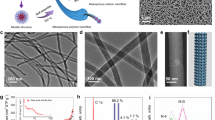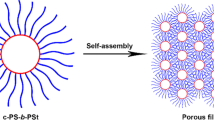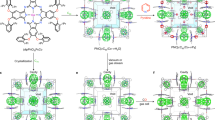Abstract
The spatial organization of porous coordination polymer (PCP) crystals into higher-order structures is critical for their integration into separation systems, heterogeneous catalysts, ion/electron transport and photonic devices. Here, we demonstrate a rapid method to spatially control the nucleation site, leading to the formation of mesoscopic architecture made of PCPs, in both two and three dimensions. Inspired by geological processes, this method relies on the morphological replacement of a shaped sacrificial metal oxide used both as a metal source and as an ‘architecture-directing agent’ by an analogous PCP architecture. Spatiotemporal harmonization of the metal oxide dissolution and the PCP crystallization allowed the preservation of very fine mineral morphological details of periodic alumina inverse opal structures. The replication of randomly structured alumina aerogels resulted in a PCP architecture with hierarchical porosity in which the hydrophobic micropores of the PCP and the mesopores/macropores inherited from the parent aerogels synergistically enhanced the material’s selectivity and mass transfer for water/ethanol separation.
This is a preview of subscription content, access via your institution
Access options
Subscribe to this journal
Receive 12 print issues and online access
$259.00 per year
only $21.58 per issue
Buy this article
- Purchase on Springer Link
- Instant access to full article PDF
Prices may be subject to local taxes which are calculated during checkout






Similar content being viewed by others
References
Putnis, A. Mineral replacement reactions. Rev. Miner. Geochem. 70, 87–124 (2009).
Antonietti, M. & Ozin, G. A. Promises and problems of mesoscale materials chemistry or why meso? Chem. Eur. J. 10, 28–41 (2004).
Cölfen, H. & Mann, S. Higher-order organization by mesoscale self-assembly and transformation of hybrid nanostructures. Angew. Chem. Int. Ed. 42, 2350–2365 (2003).
Xia, F. et al. Novel route to synthesize complex metal sulfides: Hydrothermal coupled dissolution-reprecipitation replacement reactions. Chem. Mater. 20, 2809–2817 (2008).
Roy, D. M. & Linneham, S. K. Hydroxyapatite formed from coral skeletal carbonate by hydrothermal exchange. Nature 247, 220–222 (1974).
Anderson, M. W., Holmes, S. M., Hanif, N. & Cundy, C. S. Hierarchical pore structures through diatom zeolitization. Angew. Chem. Int. Ed. 39, 2707–2710 (2000).
Xia, F. et al. Three-dimensional ordered arrays of zeolite nanocrystals with uniform size and orientation by a pseudomorphic coupled dissolution-reprecipitation replacement route. Cryst. Growth Des. 9, 4902–4906 (2009).
Yaghi, O. M. et al. Reticular synthesis and the design of new materials. Nature 423, 705–714 (2003).
Kitagawa, S., Kitaura, R. & Noro, S. Functional porous coordination polymers. Angew. Chem. Int. Ed. 43, 2334–2375 (2004).
Férey, G. Hybrid porous solids: Past, present, future. Chem. Soc. Rev. 37, 191–214 (2008).
Dincă, M. & Long, J. R. Hydrogen storage in microporous metal–organic frameworks with exposed metal sites. Angew. Chem. Int. Ed. 47, 6766–6779 (2008).
Blake, A. J. et al. Photoreactivity examined through incorporation in metal–organic frameworks. Nature Chem. 2, 688–694 (2010).
Farha, O. K. et al. De novo synthesis of a metal–organic framework material featuring ultrahigh surface area and gas storage capacities. Nature Chem. 2, 944–948 (2010).
Zhao, X. et al. Hysteretic adsorption and desorption of hydrogen by nanoporous metal–organic frameworks. Science 306, 1012–1015 (2004).
Seo, J. S. et al. A homochiral metal–organic porous material for enantioselective separation and catalysis. Nature 404, 982–986 (2000).
Kawamichi, T., Haneda, T., Kawano, M. & Fujita, M. X-ray observation of a transient hemiaminal trapped in a porous network. Nature 461, 633–635 (2009).
Takashima, Y. et al. Molecular decoding using luminescence from an entangled porous framework. Nature Commun. 2, 168 (2011).
Hurd, J. A. et al. Anhydrous proton conduction at 150 °C in a crystalline metal–organic framework. Nature Chem. 1, 705–710 (2009).
Xiao, B. et al. Chemically blockable transformation and ultraselective low-pressure gas adsorption in a non-porous metal organic framework. Nature Chem. 1, 289–294 (2009).
Zacher, D., Shekhah, O., Wöll, C. & Fischer, R. A. Thin films of metal organic frameworks. Chem. Soc. Rev. 38, 1418–1429 (2009).
Falcaro, P. et al. A new method to position and functionalize metal organic framework crystals. Nature Commun. 2, 237 (2011).
Ameloot, R. et al. Interfacial synthesis of hollow metal–organic framework capsules demonstrating selective permeability. Nature Chem. 3, 382–387 (2011).
Schoedel, A., Scherb, C. & Bein, T. Oriented nanoscale films of metal–organic frameworks by room-temperature gel-layer synthesis. Angew. Chem. Int. Ed. 49, 7225–7228 (2010).
Wu, Y. et al. Metal–organic frameworks with a three-dimensional ordered macroporous structure: Dynamic photonic materials. Angew. Chem. Int. Ed. 50, 12518–12522 (2011).
Gascon, J., Aguado, S. & Kapteijn, F. Manufacture of dense coatings of Cu3(BTC)2 (HKUST-1) on α-alumina. Micropor. Mesopor. Mater. 113, 132–138 (2008).
Horcajada, P. et al. Colloidal route for preparing optical thin films of nanoporous metal–organic frameworks. Adv. Mater. 21, 1931–1935 (2009).
Stumm, W. & Wollast, R. Coordination chemistry of weathering: Kinetics of the surface-controlled dissolution of oxide minerals. Rev. Geophys. 28, 53–69 (1990).
Masuda, H. & Fukuda, K. Ordered metal nanohole arrays made by a two-step replication of honeycomb structures of anodic alumina. Science 268, 1466–1468 (1995).
Holland, B. T., Blanford, C. F. & Stein, A. Synthesis of macroporous minerals with highly ordered three-dimensional arrays of spheroidal voids. Science 281, 538–540 (1998).
Comotti, A. et al. Nannochannels of two distinct cross-sections in a porous Al-based coordination polymer. J. Am. Chem. Soc. 130, 13664–13672 (2008).
Putnis, A. & Putnis, C. V. The mechanism of reequilibration of solids in the presence of a fluid phase. J. Solid State Chem. 180, 1783–1786 (2007).
Volkringer, C. et al. Synthesis, single-crystal X-ray microdiffraction, and NMR characterizations of the giant pore metal–organic framework aluminium trimesate MIL-100. Chem. Mater. 21, 5695–5697 (2009).
Loiseau, T. et al. A rationale for the large breathing of the porous aluminium terephtalate (MIL-53) upon hydration. Chem. Eur. J. 10, 1373–1382 (2004).
Vane, L. M. Separation technologies for the recovery and dehydration of alcohols from fermentation broths. Biofuels, Bioprod. Bioref. 2, 553–588 (2008).
Rezaei, F. & Webley, P. Structured adsorbents in gas separation processes. Sep. Pur. Tech. 70, 243–256 (2010).
Rolison, D. R. Catalytic nanoarchitectures-the importance of nothing and the unimportance of periodicity. Science 299, 1698–1701 (2003).
Tokudome, Y. et al. Structural characterization of hierarchically porous alumina aerogel and xerogel monoliths. J. Colloid Interface Sci. 338, 506–513 (2009).
Bárcia, P. S. et al. Kinetic separation of hexane isomers by fixed-bed adsorption with a microporous metal–organic framework. J. Phys. Chem. B 111, 6101–6103 (2007).
Schwertmann, U. Solubility and dissolution of iron oxides. Plant Soil 130, 1–25 (1991).
Ludwig, C., Casey, W. H. & Rock, P. A. Prediction of ligand-promoted dissolution rates from the reactivities of aqueous complexes. Nature 375, 44–47 (1995).
Guo, H., Zhu, G., Hewitt, I. J. & Qiu, S. Twin Copper Source growth of metal–organic framework membrane: Cu3(BTC)2 with high permeability and selectivity for recycling H2 . J. Am. Chem. Soc. 131, 1646–1647 (2009).
Acknowledgements
The authors thank N. Morone, the support from CeMI, and T. Tsuruoka for assistance with measurement for FESEM and K. Shiomi for assistance with breakthrough experiments. iCeMS is supported by World Premier International Research Initiative, MEXT, Japan.
Author information
Authors and Affiliations
Contributions
S.F., J.R. and S.K. conceived and designed the experiments. J.R., N.H. and M.T. performed all synthetic and characterization experiments. S.F., K.H., H.U., M.K., N.L. and O.S. carried out synchrotron X-ray diffraction measurements. J.R. carried out water/ethanol separation experiments. J.R. and S.F. analysed the data and co-wrote the manuscript. All authors discussed the results and commented on the manuscript.
Corresponding authors
Ethics declarations
Competing interests
The authors declare no competing financial interests.
Supplementary information
Supplementary Information
Supplementary Information (PDF 3725 kb)
Rights and permissions
About this article
Cite this article
Reboul, J., Furukawa, S., Horike, N. et al. Mesoscopic architectures of porous coordination polymers fabricated by pseudomorphic replication. Nature Mater 11, 717–723 (2012). https://doi.org/10.1038/nmat3359
Received:
Accepted:
Published:
Issue Date:
DOI: https://doi.org/10.1038/nmat3359
This article is cited by
-
Synthesis of zeolitic imidazolate framework-67 aerogel by anion exchange
Journal of Sol-Gel Science and Technology (2024)
-
Pickering emulsions based on sustainable MIL-101(Fe)/CNC hybrid nanoparticles for effective photocatalytic degradation of aqueous dyes
Cellulose (2023)
-
Nanostructure@metal-organic frameworks (MOFs) for catalytic carbon dioxide (CO2) conversion in photocatalysis, electrocatalysis, and thermal catalysis
Nano Research (2022)
-
Synthesis of micro-mesoporous materials by pseudomorphic transformations
Journal of Porous Materials (2022)
-
Facile and scalable preparation of ZIF-67 decorated cotton fibers as recoverable and efficient adsorbents for removal of malachite green
Journal of Leather Science and Engineering (2021)



